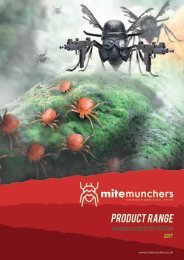MM Catalog7
Create successful ePaper yourself
Turn your PDF publications into a flip-book with our unique Google optimized e-Paper software.
SPIDERMITE PREDATORS<br />
Feltiella Acarisuga<br />
Type: A small midge that is a predator of spider mite<br />
which can be used for their biological control.<br />
How it works: Adults are around 2mm in length and a<br />
light brown colour. Larva are worm-like and yellow.<br />
Capable of flight. Only the larvae will feed on the spider<br />
mite but are voracious feeders.<br />
Species controlled: Spider mites including red spider<br />
mites (Tetranychus urticea), European red mite<br />
(Panonychus ulmi) and carmine spider mites (Tetranychus<br />
cinnabarinus).<br />
Directions for use: Usually supplied as larvae or pupae at<br />
a rate of around 250 pupae/ha repeated for 4 to 6 weeks<br />
increase to 1000-1500 pupae/ha if pest populations are<br />
high. Great for use on protected vegetables and<br />
ornamentals.<br />
FELTIELLA ACARISUGA<br />
250<br />
£96.60<br />
Orius Majusculus<br />
Type: Predatory bugs.<br />
How it works: Voracious predator of thrips, aphids and<br />
most other soft bodied prey. They often kill lots more than<br />
they need if visible.<br />
Species controlled: Orius will attack allstages of thrip on<br />
plants and most other soft bodied pest they come into<br />
contact with.<br />
When to use: Ideal to control established thrips populations<br />
on a range of plants and can be used alongside other<br />
biologicals.<br />
Rates of use: 0.5 to 1 per m2every 2 weeks until fully<br />
established.<br />
ORIUS MAJUSCULUS<br />
PREDATORY BUG IN VERMICULITE CONTAINS 500 ADULTS<br />
£96.60<br />
19











